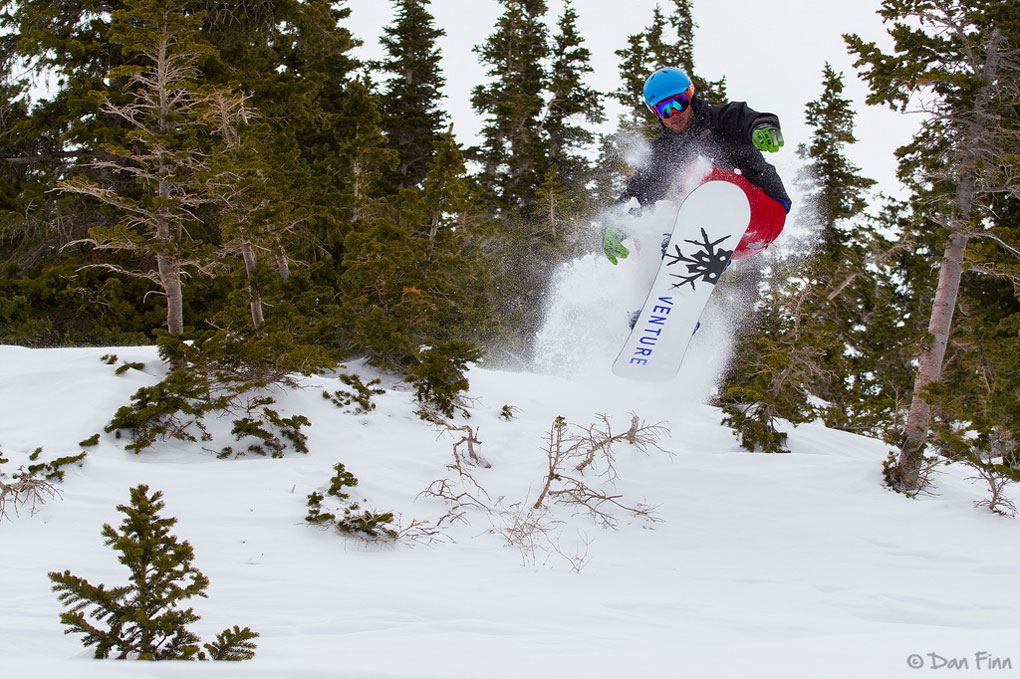Flex / Dampness
The Odin’s flex is progressive (softer at the tip, stiffer between the inserts, and softening slightly at the tail), but I’d consider it very stiff overall, and it might be one of the more torsionally stiff decks I’ve ever been on—considerably more so than the Jones Flagship. It provides a very stable platform for landing drops, as well as a confident ride at speed over inconsistent and variable terrain, as it is exceptionally damp. On everything but the hardest snow and the biggest bumps, the deflection I have often encountered on the Jones Flagship, for example, is all but non-existent on the Odin.

In short, if I’m keeping my weight centered or slightly forward on the board, it’s almost hard to get bucked. If I find myself in the backseat, there is a relatively stiff tail to help me recover. It’s win/win.
And while the shape and flex pattern are not exactly conducive to jibbing, I still found myself searching for little hits on my way back to the lift. The tail takes a little effort to load, but there’s certainly some pop there.
That said, with all that dampness and stability at speed, there is a bit of a downside. While I certainly don’t seek out moguls or huge bumps, they are often times a necessary evil when entering or exiting certain lines. If they’re too big to plow through (or over), and I don’t have the benefit of momentum to initiate a turn, the Odin can be a handful. It’s heavy, and without a little bit of speed, it can take a bit of muscle to get it around when things get tight. The same is true in the trees. The answer to this problem, of course, is usually to ride faster.
Powder Performance
I’d been wanting to get the Odin into some deep untracked snow, and the late December storm cycle in Utah finally allowed me to put it through some days in bell-to-bell, storm-day conditions. One day in particular, I managed to catch first Tram after about a foot of new snow on top of several other storms (in other words, bottomless), with terrible visibility. The traverse to South Chute (my first lap) requires a long, undulating traverse with plenty of obstacles, which is usually fine, but is much more difficult when you can’t see.
Confident that the Odin would forgive my mistakes if I hit a roller wrong and found myself off balance, I rallied to my objective quickly, without consequence.
Once in the chute, the Venture did exactly what its shape was meant to do in deep snow: float with minimal effort and without needing to stand on the tail. The taper (12 mm) allows for considerable front-foot weighting and a more aggressive turn in deep snow that I would describe as more “pivot” than “surf” style.
Over the course of a weeklong storm cycle, I was able to put the Odin through its paces in almost every imaginable condition. I had no problem keeping the Odin on top of 12 inches of 4% Utah blower, and likewise had no issues blasting through heavier, day-old crud.
Also, when finding myself traversing farther out and wedging myself into tight spaces in search of fresh snow, I found the Odin to ride switch much better than I had anticipated. The tip and tail didn’t catch as much as I would have expected on a board with 12 mm of taper, and while I wouldn’t want to make more than a few switch turns on the Venture, it’s certainly not impossible.
As is always the case when you pile a lot of new snow on top of a thin early season snowpack, I performed my own “durability testing,” as it’s hard to avoid the rocks you can’t see. I tend to ask a lot of my boards and rode the Venture like I owned it. While the base certainly shows some wear (any board would), there is no structural damage and the edges are still intact, which says a lot.
Bottom Line
My expectation, as stated above, was that the Odin would be a stiff, unforgiving big-mountain weapon, but it turns out that I was only half right: the Venture is certainly a stiff, big-mountain board, but is far more forgiving than I expected.
Perhaps the best testament I can make to the Odin is that over the last two months, on those days with no new snow where I would usually just grab a jib board, I’ve often found myself reaching for the Odin. Not because it’s that versatile, but rather it lets me make the most of bad conditions in bigger terrain. The Odin is just that fast, forgiving, and fun.
Again, there’s nothing especially revolutionary about the Odin’s shape or construction, it just seems to be a lot of simple concepts executed exceptionally well. The camber profile works extremely well with the sidecut and flex to perform well in any condition that one might find.
The one exception I might make is for those riders whose go-to terrain is tight trees at lower speeds, as the swing weight and sidecut are not ideal in those conditions.
The Odin is definitely a quiver board and is definitely on the big-mountain end of the spectrum. While it seems primarily geared to the advanced “freeride” crowd—and it performs well in that space—it’s not going to punish riders looking to advance into steeper and more technical terrain.

